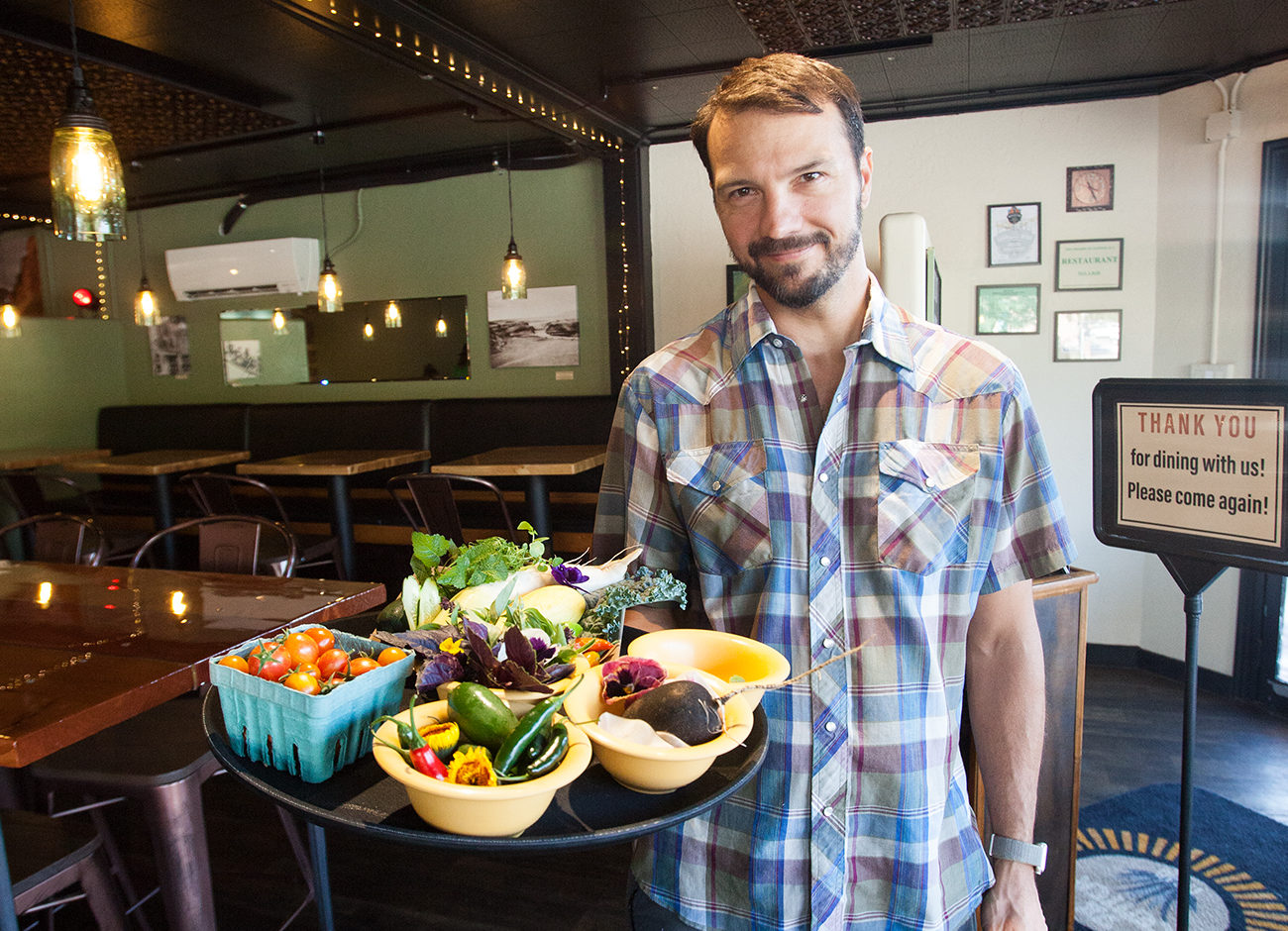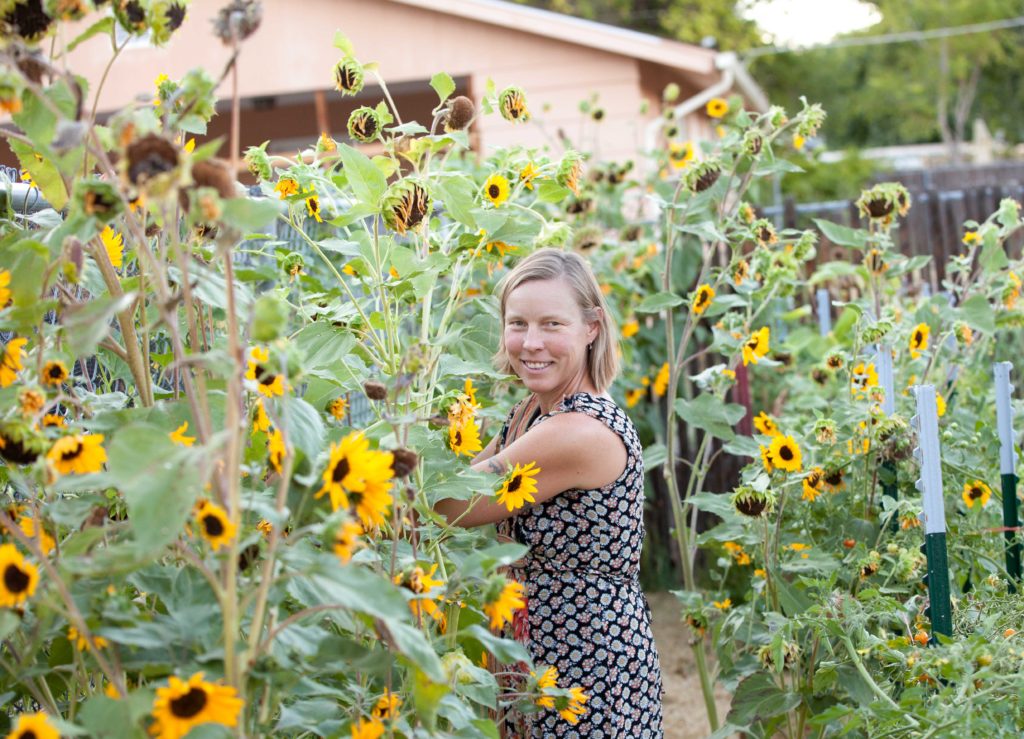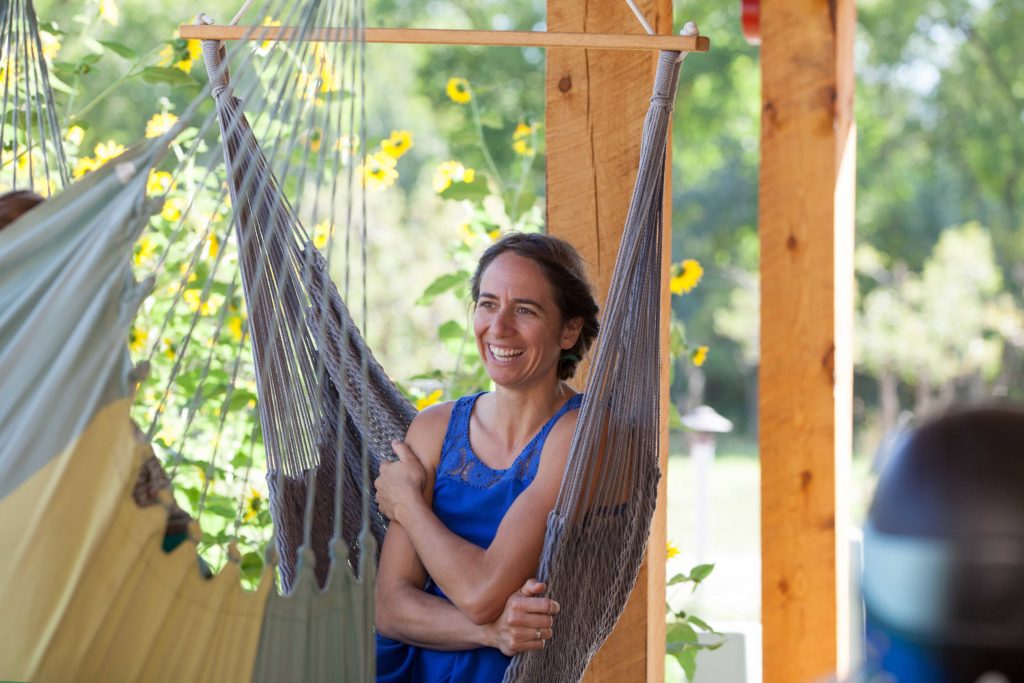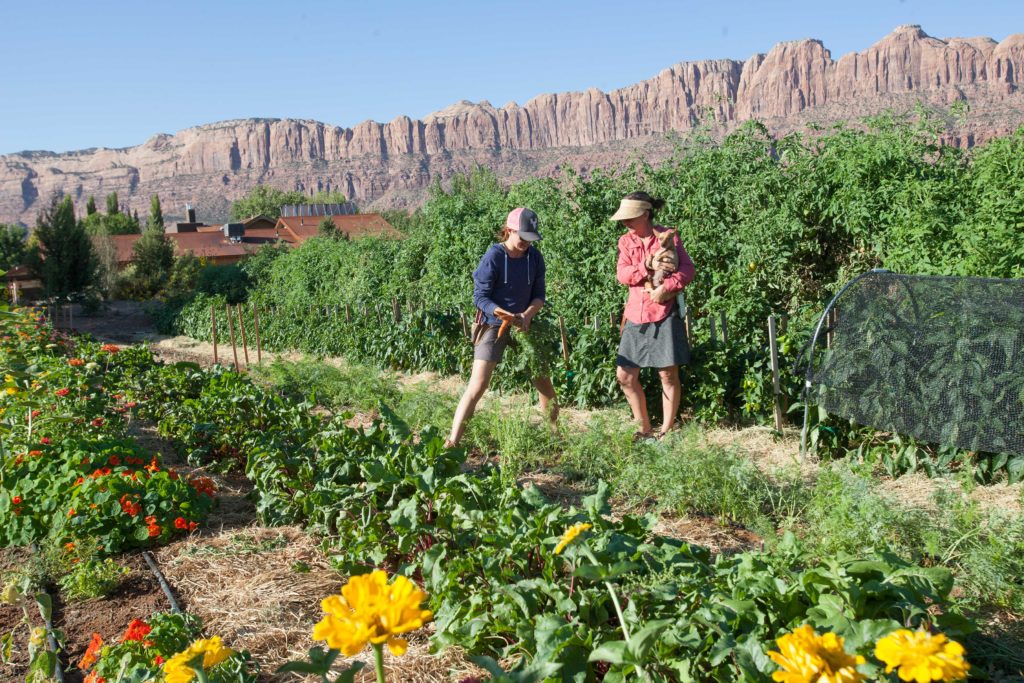Growing A Food Movement

Moab, Utah. A place where, historically, people came to pass through, hide out, or dig in. Some roots took and others dried to dust.
For centuries, humankind has grazed and gutted this land of peaches and potash. Mormon pioneers tried to tame it. Stockmen and miners came to build their fortunes or die trying. Prospectors and homesteaders flowed in and burned out. Hollywood came calling and so did the government. But in 2019, the tourists remain. They come for outdoor adventure. Shiree Duncan ‘02 wants them to stay for the food.
She looks at places revered for their native foods, like green chilies in New Mexico, and thinks Moab could carve out a niche place in the culinary world. “I feel like there is potential here,” she says. “It could be ‘Come to Moab to mountain bike and come to Moab to eat.’ It could be a win-win for the restaurants and the people that grow for them—but we are not there yet.”
Duncan managed the Moab Farmers Market and works with Roslynn Brain McCann, associate professor of environment and society at USU and Extension specialist in Moab, to connect local growers with new markets. In 2017, they inventoried agricultural production within a 100-mile radius to create a local food guide for the region. Duncan believes Moab is ripe for a resurgence in agricultural development. Despite obstacles like a limited water supply and high cost of real estate, she is hopeful that small growers can thrive here.
“It’s just finding those people who want to move down here and make that happen,” she says. “The demand is here. If a person wanted to do it, they could.”
She speaks from experience. Duncan majored in environmental studies at USU and later conducted research on native plants. But it was a visit to a Colorado farm that pointed her in a new direction. “I am supposed to be growing food,” Duncan says. “I just feel like this is my life’s purpose. It’s what makes me happy.”

Shiree Duncan ’02 gets creative about finding locations around Moab to plant her crops.
Like thousands of small growers around the country, Duncan is making a go at farming even though she doesn’t own land. She plants where she can—in the backyard of the house where she lives and in a former fallow field she tends in exchange for a lease. Duncan keeps the periphery weeded and mulched for the owner and grows pea shoots, cherry tomatoes, and cucumbers for area restaurants. She sells her greens, radishes, and carrots at the farmers market or local coop grocer.
One August evening, she and her friend Haley Olsen weed a row of purple and orange zinnias as the sun slips behind a red rock mesa shading the front yard. They calculate growing 750 pounds of produce – so far – in the 2,500 square feet they work. “I can rid of anything I grow,” she says.
“Tell your story”
Grand County has never been one of Utah’s premier agricultural regions. Early census reports show it often ranked among the least productive areas in the state. In the book The Far Country: A Regional History of Moab and La Sal, Utah, historian Faun McConkie Tanner attributes flagging agricultural ventures in Moab to its isolation. She notes that “virgin soil and an abundance of water for irrigation gave rise to a thriving agricultural society,” particularly for fruit producers. “It was the boast of people in “Sunny Moab” that they produced fourteen-ounce peaches and twenty to 25-ounce apples as everyday products,” she writes. One problem for early farmers was they didn’t have a timely way to transport yields to market.
A century later, that hurdle has largely disappeared, but there remains a disconnect between local growers and potential buyers. Enter Brain McCann. She identified “a need across the state to connect small, diversified growers with restaurants to reduce food miles and enhance farm security,” she says. And in 2012, she helped establish the Utah Farm-Chef-Fork program to connect Utah growers with local chefs.
The program is funded through a U.S. Department of Agriculture (USDA) grant and promotes relationship building between growers and restaurants through farm-chef mingles, farm dinners, and training workshops on direct marketing practices. Since its launch, one third of producers report increasing their business with chefs after attending an event. Producers learn to pay attention to details like how searchable are they online and what story are they are telling on their website? Because these details matter. “It’s extremely important to be able to tell your story,” says Brain McCann.

Roslynn Brain McCann, associate professor of environment and society, was awarded $500,000 from the USDA to connect low-income and minority families to locally grown produce.
She recently worked with Kailie Leggett MS ’18 to examine the traits most important to high-end chefs in the Mountain West. Leggett found most chefs are less enamored with labels like “organic” and more interested in the story that comes with each product. “That had a much higher appeal,” Brain McCann says. “Chefs play an increasingly important role in shaping the food market.”
Chefs like Alex Borichevsky. He co-owns 98 Center, an Asian restaurant in Moab, and chooses to stock his refrigerators with produce from local growers. When patrons enter 98 Center they are immediately greeted by its mission statement painted on the wall: “We maintain strong relationships with our local farmers and artisans by sourcing local, organic, and sustainable ingredients from our passionate partners. We are committed in … helping push Moab forward as a foodie destination and cultural hotspot.”
If he’s honest, it was the water that drew Borichevsky to Moab years ago. He came as a river guide, but he had worked in kitchens since he was 15 and that made him want to open his own one day. Using local ingredients was something he endeavored to do, but sourcing wasn’t reliable, he says. “It was very inconsistent.” And when you run a kitchen, you need to know you have a steady supply of onions and carrots, coming. Ordering from a vendor is easier—you know it will come, he says. You just don’t always know how good it will be.
Things started changing in December 2017. He and Natali Zollinger, manager for 98 Center, developed a list of their needs and shared them with local producers to budget into their spring planting. Now, the restaurant sources about half of their ingredients locally, including cherry tomatoes, cucumbers, basil, peppers, onions, mixed greens, flowers, eggs, and herbs.
Duncan and Brain McCann helped bring farmers to the table by organizing meet and greets with restaurateurs, Borichevsky, says. Many don’t have time or marketing savvy to take their product around for restaurants to sample. About a dozen Moab eateries now purchase some of their ingredients from area producers, a move that keeps money in the community, reduces food miles, and preserves farmland.
“There is a lot of sacrifice as a restaurant to go local,” Zollinger says. “There are a lot of people that aren’t ready to sacrifice the margins. Asian food is known to be cheap. And we are not cheap.”
One problem is customers don’t always make the connection with what they are eating and where it came from and how it was produced, she says. “They don’t see that we use grass-fed meat. We don’t use GMO foods, MSG, rancid oils, or high fructose corn syrup. That package is why we cost more.” Zollinger believes 98 Center is more than the food it prepares.
“Food is fuel,” she says. “It is medicine. It is information for your body to grow in new directions.”
“Areas of Hope”
Brain McCann sees the local food movement taking shape in the form of intensive, small plot farming like what her former intern Duncan is doing. “I think that type of model could work really well here,” she says. “Moab is too expensive for young farmers to come in and buy.”
Sitting on a porch swing outside her straw-bale house, she points out the graywater system—the state’s first legal residential one. The two-bedroom home overlooks an orchard shared by the neighborhood. Brain McCann pays less than $9 a month for electricity. She does more than teach sustainability to USU students—she lives it. Part of her job description is to facilitate community-level environmental change. Connecting local growers with restaurants is just one bullet point in her plan to improve environmental practices in the region.
Moab averages less than 10 inches of rain a year and its economy is largely tourism based. In 2017, the Moab Chamber of Commerce reported that more than 83 percent of taxable sales was generated from tourism-related industries. With six hotels already in the construction queue, many residents wonder how the town can support additional growth.
If we were effectively using our rainwater we wouldn’t be in a water crisis, Brain McCann says. She is helping revise the state’s graywater policy to make it more feasible for Utah residents to collect rainwater. This year, during her sabbatical, Brain McCann will visit 20 research sites across the country to study how various permaculture techniques can be applied in the desert. Afterward, she will implement a nearly $500,000 grant awarded by the USDA’s Farmers Market and Local Food Promotion Program to connect low-income and minority families to locally-grown foods. This opens another segment of the market to local growers and ensures the program doesn’t just touch “foodies,” but also the populations most vulnerable to food insecurity. These days, Brain McCann is optimistic about the prospects for agriculture in the region.
“I’m seeing a lot of interest in farming in younger generations—a lot of innovative approaches, too,” she says. “I’m noticing a burning desire to enact positive change.”
Twelve miles down the street, the staff at Easy Bee Farm are picking green onions for Community Supported Agriculture (CSA) baskets being prepared for delivery. Owner Rhonda Gotway inspects a row of peppers while talking about her childhood in Calhoun County, Illinois where soybean and corn fields abound. Her grandmother always planted a garden, an act that influenced Gotway for life. After college nearly 30 years ago, she moved to Utah for a job with the Student Conservation Association and never left.
Gotway purchased land once used to farm alfalfa and spent three years re-mediating the soil in her spare time. Most of this land was alfalfa fields, she says gesturing to her neighborhood of single family homes flanked by the La Sal Mountains. Gotway farms using low-water methods and Easy Bee Farm doesn’t use all of its allotted shares for operations. She acknowledges the start-up challenges for would-be farmers are difficult to overcome because property values are so high. Most new farmers can’t do it, she says, but, if you can buy two acres and live down here, why not make it usable? “I see an opportunity to farm this old agricultural land.”
Easy Bee Farm benefits from a steady supply of local volunteers—people she relies on. The moments Gotway is most stressed are when she considers “the future and how I’m going to keep this all going—I can’t do it by myself. If don’t have that community support, I’m done.” Gotway teaches area residents how to repair their land and sees her work as training the next generation of farmers like her business partner Jess Oldham ’09.
“I feel positive about this generation,” Gotway says nodding toward Oldham.

Demand for produce from Easy Bee Farms grows every year.
It’s a true partnership. The farm is located on Gotway’s land and grows with Oldham’s enthusiasm. Over the last four years the farm has increased the amount of produce they supply to area restaurants and expanded CSA shares. Oldham studied international studies at USU, but felt overwhelmed studying the problems of the world. Farming made sense.
“Gardening is simple. It’s a way of making a difference. It’s a form of activism,” Oldham says while organizing chives on a cutting board. “I can’t save the world, but I can save myself and a bunch of other people.”
Part of Easy Bee’s role is to educate the community about what is possible, she says. “It’s in our history. The fruit trees, they were all part of the early settlers. We have the climate. We have the soil. Everyone knows Moab for its red rocks, but people don’t know one pound peaches grow here … We live in a little [reservoir] in the desert—there’s so much potential.”
To learn more about the Utah Farm-Chef-Fork programs, events, and trainings, visit USU Extension.





